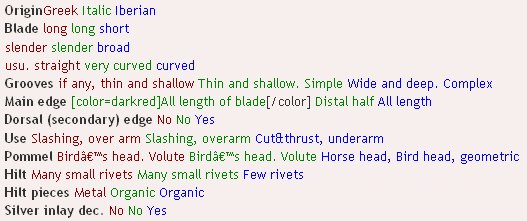What would be the best, regarding authenticity and aesthetics, for falcata/kopis fittings and grip?
Bronze fittings with organic grip?
Antiqued brass fittings with organic grip?
Steel/wrought iron fittings with organic grip?
All fittings and grip organic?
Regarding the organic grip:
Horn?
Bone?
Various colors and types of wood?
Also, I know it would be "inauthentic", but would a hammer-textured blade look good on a falcata/kopis?
Thanks, y'all.
~John
| John Cooksey wrote: |
| What would be the best, regarding authenticity and aesthetics, for falcata/kopis fittings and grip?
Bronze fittings with organic grip? Antiqued brass fittings with organic grip? Steel/wrought iron fittings with organic grip? All fittings and grip organic? Regarding the organic grip: Horn? Bone? Various colors and types of wood? Also, I know it would be "inauthentic", but would a hammer-textured blade look good on a falcata/kopis? |
the bronze is fine, skip the brass, steel is ok too. Organic handle scales, whether they be bone, horn, or wood is fine. Olive wood, holly or something indigenous too the parts of the world where this sword was used. Walnut wood work as well I suppose. Ash maybe, or elm.
As to multy-coloured wood. I have misgivings that the effect would come off too "modern". As to the hammered texture, that would really be matter of opinion. I would think that it would encourage rust though. A clean polished blade has problems enough with that. At a minimum I think you should incorporate some kind of bolster/guard of bronze or iron. There's my suggestions.
This is a bump...
Also can anyone direct me to information involving how these hilts where put together? I have seen a lot of pictures of originals, but it is very hard to make out anything related to construction.
Also can anyone direct me to information involving how these hilts where put together? I have seen a lot of pictures of originals, but it is very hard to make out anything related to construction.
No bronze or brass was used on the falcata (Greek kopis did have bronze hilts, but they are quite different overall). The bolsters are iron, attached usually with two rivets. Below you can see an example where the rivets are drawn (series B, no. 2). The rivets are usually hammered/ground flush, so you don't see the rivets.
[ Linked Image ]
Of the organic material, I don't have much information. This example has a white material, which could be bone or ivory (most likely):
[ Linked Image ]
I'd expect wood and horn would have been used as well.
[ Linked Image ]
Of the organic material, I don't have much information. This example has a white material, which could be bone or ivory (most likely):
[ Linked Image ]
I'd expect wood and horn would have been used as well.
On some of the examples I see what appears to be metal fittings at the terminus of the handle (the end part that wraps up around the users pinkie and ring finger). Does anyone know how these had been attached? I have seen examples where the hilts terminus has a little but plate with a single attachment point in the middle. How where these attached? Was the little rivet coming through the center of these end plates part of the tang? With examples of Greek kopis, was the entire hilt made of bronze, or just accents?
I have looked over the falcata / kopis thread, but have yet to be able to determine the difference between a typical Greek kopis and an Iberian falcata. What where the main difference?
I have looked over the falcata / kopis thread, but have yet to be able to determine the difference between a typical Greek kopis and an Iberian falcata. What where the main difference?
| Luke Zechman wrote: |
| I have looked over the falcata / kopis thread, but have yet to be able to determine the difference between a typical Greek kopis and an Iberian falcata. What where the main difference? |
Here is a summary by Fernando Quesada, the main expert on the subject:

N.b. here are some kopis examples, of which pictures are pretty rare. Both are from the National Museum in Athens:
 Attachment: 3.02 KB
Attachment: 3.02 KB

 Attachment: 94.35 KB
Attachment: 94.35 KB

 Attachment: 156.69 KB
Attachment: 156.69 KB
[ Download ]


[ Download ]
OK now I am getting a better handle on things. Seems to me that the average kopis may have been longer and more slender. I have seen that Ibis shaped handle in at least one reproduction. Seems as though the back of the blade was straighter then a typical falcata, without that pronounced bend forward (toward cutting edge) seen in a lot of other examples. I have been working on a scale design today, and will be trying to post some pictures for critique.
Page 1 of 1
You cannot post new topics in this forumYou cannot reply to topics in this forum
You cannot edit your posts in this forum
You cannot delete your posts in this forum
You cannot vote in polls in this forum
You cannot attach files in this forum
You can download files in this forum
All contents © Copyright 2003-2006 myArmoury.com — All rights reserved
Discussion forums powered by phpBB © The phpBB Group
Switch to the Full-featured Version of the forum
Discussion forums powered by phpBB © The phpBB Group
Switch to the Full-featured Version of the forum